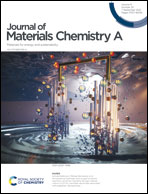An oriented Ni–Co-MOF anchored on solution-free 1D CuO: a p–n heterojunction for supercapacitive energy storage†
Abstract
Herein, we propose an effective strategy to enhance the electrochemical activity of a metal organic framework-based (MOF) electrode material for electrochemical capacitors. The fabrication involves the synthesis of CuO nanowires on a Cu substrate through a facile solution-free dry oxidation route followed by the deposition of an oriented Ni–Co-zeolitic imidazolate framework (Ni–Co-ZIF) on 1D CuO. This synthesis strategy benefitted from the highly exposed redox active sites of the aligned Ni–Co-ZIF, an “ion and electrolyte repository”, to assist the diffusion of electrolyte ions, and a p–n heterojunction between CuO and the Ni–Co-ZIF. ZIFs represent an emerging and unique class of MOFs. The oriented pseudocapacitive Ni–Co-ZIF@CuO composite electrode yielded excellent electrochemical merits including a high gravimetric capacitance which is 3.3- and 2.1-fold higher than those of the self-supported CuO and bulk MOF, respectively. Furthermore, we employed first principles density functional theory calculations to study the enhanced electronic conductivity and reduced work function of Ni–Co-ZIF@CuO systems upon CuO doping, which reinforced the experimental findings. Moreover, an asymmetric supercapacitor (ASC) device was assembled to evaluate the application of the as-fabricated electrode material for electrochemical capacitors. The gadget delivered a maximum energy density of 43 W h kg−1, with improved cycling stability after 10 000 cycles. The oriented Ni–Co-ZIF@CuO with remarkable electrochemical activity and mechanical flexibility inspires for next-generation MOF-based electrode materials with superior electrochemical attributes.



 Please wait while we load your content...
Please wait while we load your content...